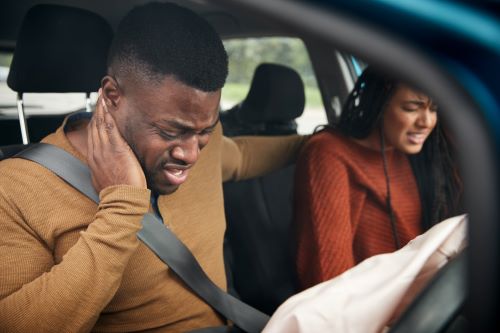Book a Consultation
Find out why so many clients appreciate the amount of work we put into their case.
"*" indicates required fields
Call 24/7

It’s the aftermath of a car accident. People are confused, vehicles are totaled, and you’re stuck in the middle of it all.
The first thing you want to do is make sure everyone is safe, starting with you. But after that, it’s eventually going to sink in that you now have injuries and damages to pay for, and to do that, you need the other driver’s insurance information.
And that’s where you run into a problem. Drivers are required by law to present their insurance information to other drivers in an accident, but they don’t always cooperate.
There are bad actors who try to weasel out of having to take accountability for an accident they caused. The anxiety of having to deal with this makes confronting another driver difficult – but that doesn’t change the fact that it’s necessary.
Even if Personal Injury Protection (PIP) is sufficient to cover medical expenses, fault in a car accident still matters for the purpose of property damage. For this, you want to get the at-fault driver’s name, address, vehicle registration, insurer, and the insurer’s contact number.
Utah law requires these to be presented upon request after an accident, but it is also smart to ask for other information including the other driver’s contact number and the insurance policy number as well, if they are willing to provide it.
Simple enough, but with emotions running high, it may be hard to get these details from another driver. If you have difficulty getting their information, try the following:
Do not be discouraged if the other driver refuses to provide information. Your car accident attorney in Salt Lake City may offer other avenues through which you can pursue compensation, such as a lawsuit.
If you need help with this, call Valley Law Accident and Injury Lawyers at 801-810-9999, or contact us online via this link.
The series of steps you take after a car accident is pretty straightforward. Generally speaking, you want to prioritize the safety of yourself, then that of others, and then proceed with other concerns.
It is important to read the situation, though. Some steps might have to give priority to others depending on what is happening at any given moment.
This should be your immediate reaction as soon as your brain realizes you’ve been in an accident. Get your bearings, assess the situation, and move yourself and any loved ones to safety.
Context matters, of course.
If you’re a passenger trapped by a car seat or a pedestrian pinned against a wall, you’re not going to be in any position to move away. But the general rule here is to do whatever is in your power to stop the situation from getting worse.
So, if you’re trapped in a car seat, turn off the ignition, unlock your seatbelt, and make yourself visible for people to help. If you’re stuck against a wall, try to get rid of anything that might hook against the vehicle so you can make it easier to help you.
Finally, “move away from danger” also means “don’t pose a danger.” If you were involved in a minor accident and no one was hurt, move out of the way of traffic before anything else.
Once you’re out of harm’s way (or once the vehicles are out of the way, as the case may be), check yourself for any injuries. Your health is paramount, and none of the following steps on this list will matter if you aren’t around to take them.
Once you know you’re ok, you can move on to checking everyone else.
You should also contact the police and, no matter how minor the accident, call emergency medical services.
Police will help mediate the situation, make the first observations and conclusions of what happened, and file a police report, which comes in handy for all parties involved later on. Utah law also compels drivers to provide identification to police upon request.
Emergency medical services will ensure the health and safety of those involved. If there is a risk of fire or if specialized equipment is needed for extraction, EMS will work hand-in-hand with the fire department.
You may also have to perform first aid on yourself or look after people at the scene before emergency personnel arrive. If so, take note of the following:
Have medical respondents treat your injuries as soon as they arrive. Also, have them check you for any injuries you might have missed.
As someone who was at the scene before they arrived, you can assist respondents by describing the situation, providing information about hazards and victims, or providing assistance.
Typically, emergency services can act on their own, but if you offer help, follow their instructions. This holds true even if their instruction is as simple as to keep the area clear and stay out of their way otherwise.
Keep in mind that, again, context applies. Depending on the severity of your injuries or those of other people involved, you may need to delay the steps after this one.
Another driver can’t provide you with their information if they’re being rushed to the hospital. Neither can you if you were in the same situation.
It is at this point that you need to exchange information with the other driver. As we’ve outlined, make sure you get names, contact information, vehicle information, the insurance company, and their policy number.
Remember to do this for all drivers involved. This is where the presence of police can come in handy.
People might not want to cooperate with you after an accident, even if failure to provide insurance details is a class C misdemeanor. But the presence of a police officer can work in your favor.
Typically, drivers do not need to present police with ID if they do not have reason to suspect a crime (Oversimplification, but it’s what’s relevant here). However, a car accident is enough grounds for an officer to suspect someone was doing something wrong that led to the event.
It is also illegal to drive without a license in Utah, and a car crash can prompt officers to verify if everyone involved is licensed and – because insurance is required by law – insured.
Take photographs of the scene, and if you want to be really thorough, record any conversations that take place. Both audio and video recordings can help.
Documentation helps your case when you finally have to sit down with your insurance company and make a claim. It also helps support (or disprove) any information in police reports or the accounts of other drivers.
When documenting the scene, include injuries, damage to your vehicle and those of others, and damage to any property you may want to include in your insurance claim.
This is where the insurance claims process sets in motion.
When you contact your insurance company, provide them with your documentation of the event. Again, include the date, time, and location; names and contact details of parties; and extent of injuries and damages.
Utah is a no-fault state, which means regardless of who caused the accident, involved parties will turn to their PIP before pursuing other options. However, even if the accident falls under one of the exceptions to this rule, it’s still your provider you should call.
If another driver is at fault, your provider will try to contact the other drivers and/or the associated insurance provider(s). If the other parties refused to provide you with information, you can still get a copy of the police report, which potentially includes the details you need.
Once the claim process begins, your insurance company may offer to handle everything for you. While this might work to your advantage and allow you to sit back and relax, there is a caveat to keep in mind.
Your insurance provider does have an interest in providing you with compensation: after all, you are their customer, and they need to keep you around. However, they also have an interest in minimizing claims, as any money they spend cuts into their profits.
At the end of the day, insurance companies are a business. And while there is nothing inherently wrong with prioritizing the business, this leads to less than favorable outcomes for you.
Working with a lawyer at this point will help you build a solid claim and stand on even ground with the insurance company’s adjuster when they make you an offer. In fact, working with a skilled car accident lawyer before this point can be advantageous.
The step-by-step process after a car accident isn’t too complicated. But the stress of the event can be enough to make you miss important details or just be too much to handle while you or your loved one go through medical treatment and recovery.
So whether it’s for a lowballed offer by your insurance provider or legal action against a driver who refuses to pay damages, we’re here for you.
If you need help at any point after a car accident or during the claims process, contact Valley Law Accident and Injury Lawyers. Call us at 801-810-9999 or click this link to reach out to us via our online contact form.
Your case evaluation is free, and we do not get paid unless we win your case.
Get in touch


2021 and 2022 Gold Winner for Top Law Firm by Salt City Best
Call 24/7 801-810-9999